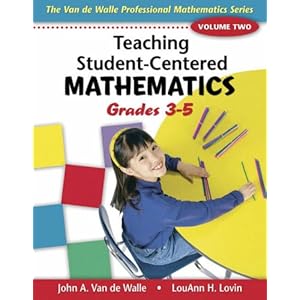By my own self-assessment, I am a total nerd. I am incredibly lucky to have a career that interests me. In my free time, I read all sorts of professional books to improve my educational prowess I call it "nerding out" and that is what Josh has come to refer to it as well. Usually, I gravitate to books where as I am teaching the subject, I have doubts that I am using best practice. For example, math. When I was a student, I loved math! It came easily to me and simply made sense. However, when you excel at something, it doesn't always mean you are amazing at teaching it. Kind of how professional sport stars, don't always make the best coaches (*cough* Wayne Gretsky *cough*).
Luckily for me, there are books written about best teaching practice based on years of research and the successes of other teachers. My current "nerd" book selection is Teaching Student Centered Mathematics by John Van De Walle and Lou Anne Lovin. So far, it has completely rocked my teaching world and challenged some of my beliefs about teaching mathematics.
In recent years, I have taught in a skill-based format. As in, we pick a skill, such as simplifying fractions, and teach that explicitly. For all the non-education folk, explicit teaching is a huge buzz word right now. Basically, it means "I do. We do, You Do.". The teacher models how to do a specific task, the class then does a related task together and then the student is expected to do a similar task by themselves. Makes sense, right? Of course, but what I'm learning is that by using only this method in math, my students are missing a very important piece in their math education: conceptual understanding.
Van De Walle argues that when we teach math skills in isolation, we are merely asking students to memorize a procedure. The procedure has little chance of being memorized, because the student has no clue to the concepts behind the procedure. Instead, Van De Walle suggests that instead of the teacher "telling" the procedure, the teacher should instead facilitate tasks in which students problem solve to figure out their own procedure.
Here's an example. Teaching fifth graders how to find the mean (average) of a set of numbers has always been frustrating to us fifth grade teachers. We "tell" them to add the numbers and then divide by the number of addends (numbers they added together). This works wonderfully, the students get it and we move on to the next skill. Problem is, two weeks later when asked to find the mean of a set of numbers, nearly ...every... single... student will forget how to find the mean. Why? My conclusion is that they have no idea what they are doing. We, as teachers, have not provided the tasks that are necessary for them to acheive conceptual understanding. (Love that phrase! Using it makes me feel smart :-)
So, I have a new plan for this year. Instead of teaching the students the procedure for finding the mean, they will be problem solving and doing the activities that Van De Walle suggests for acheiving that conceptual understanding. Through one of the activities, students actually discover the algorithm for finding mean by themselves.
So, you're on Van De Walle! As a teacher, it looks to me like this way will work. I'll update here with the lessons and hopefully will finally have students who UNDERSTAND how to find a mean instead of reciting a procedure.


Jo- you are just amazing. I marvel at your teaching strategies and applaud your desire to learn more.
ReplyDeleteAnd once you've taught them mean, you can move on to median and mode. Binomial, Poisson, and normal distributions. Standard deviations, confidence intervals, and correlation coefficients. Regression analysis, degrees of freedom, random and systematic error. Makes me all tingly just thinking about it. :-)
ReplyDelete